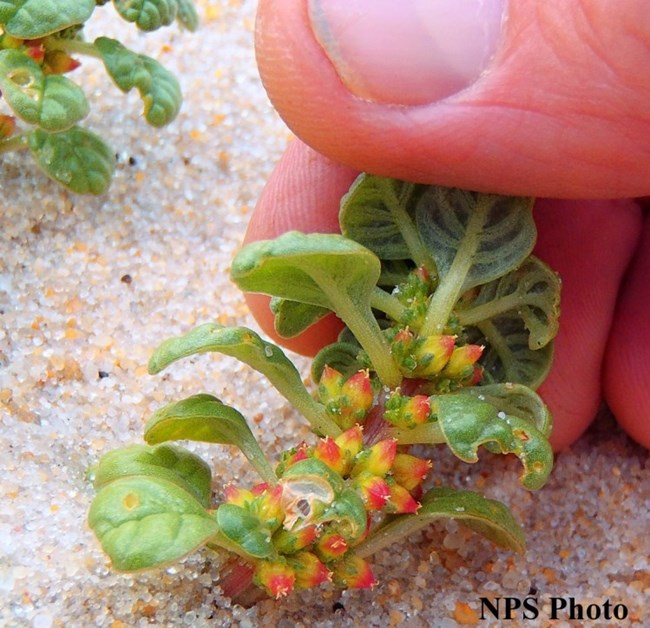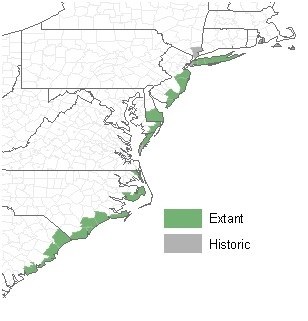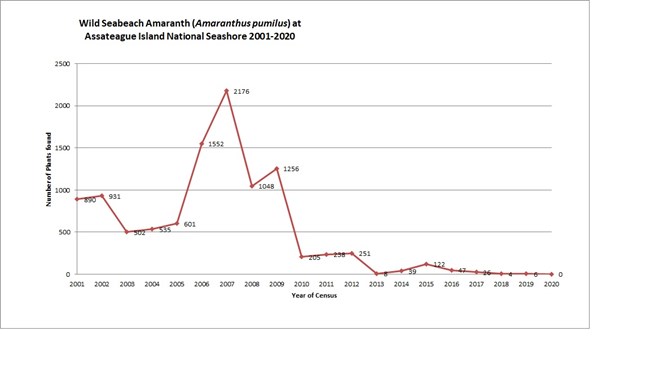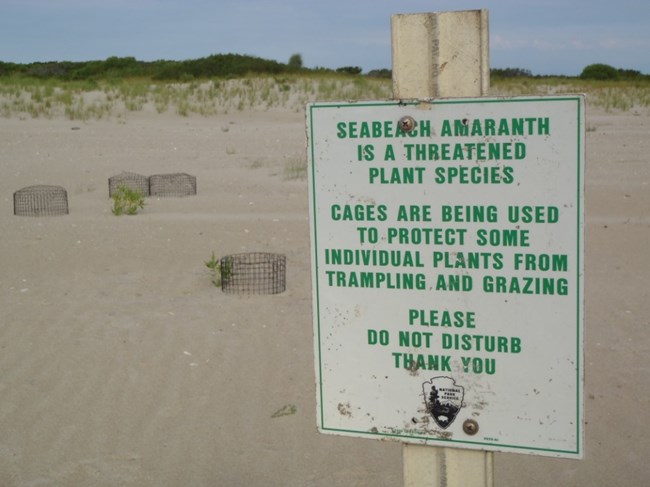
NPS Photo BackgroundSeabeach amaranth (Amaranthus pumilus) is an annual vascular plant native to the sandy Atlantic barrier island beaches. The low growing plant some times has redish stems with waxy, wrinkly leaves clustered at the end. Petite yellow flowers, produced on the underside of the plant, typically produce seeds until the end of September.Amaranth habitat is generally open and sparsely vege tated, with low plant diversity. It is typically found on the upper beaches and in overwash areas. Overwash occurs when ocean water rushes across the island during periods of high water and wind. As sand is depos ited on the island interior, it covers up large areas of vegetation. This activity creates prime habitat for amaranth where it will grow better without competition, as it is easily outcompeted by more aggressive plant spe cies. After a storm, thanks in part to long distance seed dispersal and possibly long-lived seed banks, amaranth is able to colonize new habitat. 
USFWS Status and TrendsHistorically, seabeach amaranth occurred along the coast in nine states from Massachusetts to South Carolina. However, by the time the plant was listed in 1993 as a threatened species under the U.S. Endangered Species Act, it was believed to have been extripated from six of nine states in its natural range. At the time it was listed, seabeach amaranth was limited to coastal Long Island, New York and to barrier islands from Dare County, North Carolina to Charleston County, South Carolina; no plants were found in Maryland.The primary cause of the decline of seabeach amaranth is believed to be development and stabilization of barrier islands. These processes reduce or eliminate natural disturbances like overwash that would otherwise create new habitat for the species. In some areas, recreational activities such as over-sand vehicle use, intensive foot traffic and beach grooming may have also contributed to population declines. Restoring seabeach amaranth populations may have societal values beyond maintaining biological diversity. It is currently being investigated for agricultural use, given that its seed is high in protein and low in carbohydrates. Additionally, as a species that grows at the lowest topographic position of any vascular plant on barrier beaches, it may lend insight into the phenomenon of sea level rise. 
NPS Management and MonitoringLast observed on Assateague in 1967, seabeach amaranth was rediscovered on the north end of Assateague in 1998. This was the first verified record of the plant on the island in 31 years. Subsequent plant surveys by scientists identified only seven other plants. At this point, scientists determined that it would be necessary to attempt an experimental restoration of the species using wild plant material acquired from plants growing on Assateague. Goals for the restorations effort were established based on the mandatory U.S. Fish and Wildlife threatened species recovery plan for seabeach amaranth.Seabeach amaranth seeds were cultivated into seedlings at a greenhouse operated by the Maryland Department of Agriculture. In 2000, with only four plants growing in the wild, an additional 1,156 seedlings were planted. Fewer than 1,000 of those planted survived to be counted in the 2001 plant survey. The same year, an additional 2,444 seedlings were planted and again, less than 1,000 survived to be counted in the 2002 survey. An additional 1,881 plants were planted in 2002, however, by the 2003 survey, about half of the population was lost. It is very likely that the high rate of mortality during the first three years of the experimental restoration could be attributed to plant shocking, strong winds and planting in unsuitable habitat. An additional impact that may have influenced plant mortality was excessive grazing by horses and deer. In instances where evidence of grazing by horses was found, the plants had most of their aboveground biomass eaten. These plants were frequently killed; surviving plants resprouted leaves, however it was clear that reproductive losses were experienced. 
NPS Photo In 2004, round, wire mesh cages were deployed around individual and clusters of plants. The top of the cage was also covered with mesh so that herbivores could not stick their heads inside the cage to graze on the plants. This approach proved to be much more successful and may have been a key element that contributed to an increase in the seabeach amaranth population in subsequent years. Even with wire mesh cages deployed to protect the amaranth, there are additional factors that may influence the plant's fluctuating population. Insects such as grasshoppers, caterpillars and beetles consume the leaves of the plants, often defoliating them. Even though most plants regrow new leaves, they often loose reproductive potential. Additionally, drought and disease affect the success of the plant growth and its ability to produce. At present, seabeach amaranth population biology is poorly understood. The continued annual monitoring as well as the deployment of protective cages around identified plants and colonies, will allow us to persist in our efforts to gain further insight into the root causes of population fluctuations. |
Last updated: February 15, 2021
